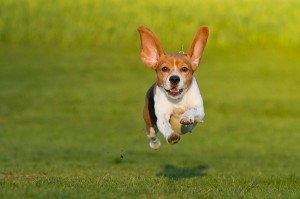 Apart from being essential for safety reasons, when your dog has mastered the come command he/she can be allowed greater freedom in many situations. For example, when you are down at the beach or out hiking your dog can go off exploring on her own but will always be alert and ready to respond to your come command. This gives all of us dog owner’s piece of mind and is very reassuring.
Apart from being essential for safety reasons, when your dog has mastered the come command he/she can be allowed greater freedom in many situations. For example, when you are down at the beach or out hiking your dog can go off exploring on her own but will always be alert and ready to respond to your come command. This gives all of us dog owner’s piece of mind and is very reassuring.
Your ultimate goal when teaching the come command (sometimes called recall) is to receive an immediate response from your dog upon hearing your command, every time, regardless of what else is happening in the area at that time.
Let’s not kid ourselves though, this type of response is not always easy to achieve. The come command can take a lot of work, and the truth is that it is very difficult for some dogs to get 100% right. For certain breeds and dogs that love to chase or have a strong scent drive the come command actually works against their natural instincts.
Don’t let this put you off though, you can succeed using the techniques outlined below. Basically you can teach the come command as soon as you get your new puppy (the earlier the better) or even an older dog, and you’ll be reinforcing it every time you are with your dog throughout his/her life.
Why Doesn’t Your Dog Come When Called?
These are the most common reasons why our lovely dogs seem to ignore us and don’t come when we call them.
- Your dog does not understand what the “come” command means, she simply doesn’t know what you are requesting her to do.
- Your dog may have been allowed to get away with disobeying your come command in the past and was not held accountable for her actions (or lack of action!).
- Your dog may believe that following the scent trail of a squirrel or continuing to romp around with other dogs at the park is more appealing than coming back to you.
- Maybe your dog has responded well to your command in the past but was inadvertently punished for her good behavior. This could mean that you called her over then immediately locked her in a crate, or called her over and plunked her straight into a soapy bath (which she hates!).
General Rules to Keep In Mind When Training the Come Command
- Never under any circumstances punish your dog when she comes back to you. Even if your dog seems to take an eternity to respond to you and you’ve got smoke coming out of your ears through frustration, it’s important that you don’t get angry with your dog. She’ll associate your anger with the last action she did – which was coming to you.
- Your goal is to make coming to you a more attractive option to your dog than any other alternative action.
- Never let your dog off leash in public before you have your dog responding very well to your come command. Your dog has to work her way up to this privilege – see the steps involved in training the come command below.
- Your come command should be something your dog looks forward to hearing, something she has a positive association with. You do this by making it wonderful each she comes to you, make it worth her while. Certainly do not only use the command to call your dog over to snap the leash back on after an off leash run, or to call her away from fun.
- Incorporate the come command training into your daily activities. Use it to call your dog over for her dinner or call her over at any time just to give her a scratch behind the ear or a tasty treat.
- When you are teaching your dog the come command off leash and your dog doesn’t respond, don’t chase after her, first try waiting for her. If you do have to go and retrieve her don’t punish her when you catch up with her, just go home or start your training session again, this time on leash.
- Never call your dog in situations where you know your dog won’t come to you. You don’t want your dog to think that sometimes it is ok if she doesn’t respond to your “come” command. It has to be every time, and your dog must never get away with not respecting it.
- As with all obedience training commands start your training sessions out easy, master one step then move on and build upon it. Challenge your dog along the way, but don’t move too quickly. Your dog will gain confidence all the way along this process.
Depending on what level you and your dog are up to in your obedience training, you can apply one or all of the steps outlined below. I’ve found that if you apply repetition, reinforcement and patience to these training techniques, you and your dog will achieve great results.
Training the Come Command!
- Young puppies love to follow you around and often bound up to you with great delight – use this to your advantage. At this early stage all you need to do is make it clear to your puppy that you are happy to see her each time she comes to you. Make it a very pleasant and rewarding experience, every time.
- The next step is to introduce the verbal “come” command so that your dog connects its use with the act of coming to you. Start inside your home with no distractions around, crouch down or kneel, then in a friendly and welcoming voice say “come”, you can even wave a tasty treat around to lure your dog over if necessary. When your puppy (or older dog) gets to you, immediately praise and reward her effort. Repeat this exercise many times throughout the day to reinforce the connection.
- If you have someone else there to help, you can now introduce the “back and forth” game. Position yourself at one side of the room and your helper on the other side. Call your dog over (only once, but you can encourage her over, “good girl’), then reward when she arrives. Next your helper calls her over and rewards her when she arrives.
This game is a lot of fun for your dog and teaches her to respect the “come” command from a person other than yourself. You can extend this exercise into a game of hide and seek by going into a different room to your partner, call your dog and let her find you. Make it worth her while when she does track you down – most dogs love this game.
- Now you are confident your dog understands and is responding quickly to your “come” command you can reinforce it in different environments and situations. Put your dog on a leash (just the one you take her on walks with) and head outside. Call your dog with the same “come” command and walk backwards, when she comes close to you give her a treat and a nice scratch behind the ear. Practice this at various stages throughout your normal walk; don’t forget to always praise your dog’s good work!
- The next step you can take is similar to step 4 but this time clip a long line on instead. This is a lightweight piece of rope which you can buy at pet stores or from hardware and camping stores. To start put the long line on in a familiar environment (like your yard) and then you can progress to public places (like the park) when you are ready.
Continue to call your dog over “come” and praise her when she does, then send her on her way again. If your dog ignores you, give a light tug on the long line. As soon as she starts coming your way reinforce her “good girl”.
- Next you can challenge your dog off leash in an area where you have been practicing.
If at any time while working through these steps your dog doesn’t seem to be “getting it” simply take it back a step and work on an easier level. Remember that training your dog is an ongoing process, continue to build upon and proof your good work each day.
For more information about our programs visit our website at www.perfectpetdog.com or call us at 803-210-9380.

Leave A Comment
You must be logged in to post a comment.